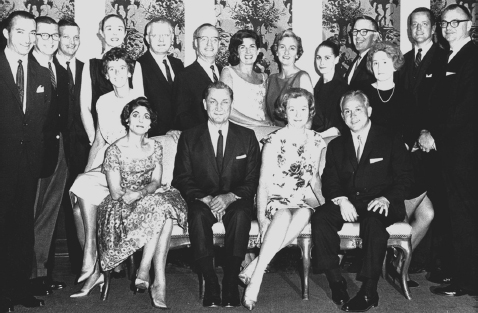
Leaders in Plastic Surgery
Skip other details (including permanent urls, DOI, citation information): This work is licensed under a Creative Commons Attribution-NonCommercial-NoDerivatives 3.0 License. Please contact [email protected] to use this work in a way not covered by the license.
For more information, read Michigan Publishing's access and usage policy.
CHAPTER EIGHT: Plastic Surgery Extending Beyond Ann Arbor and the University of Michigan
We now move on to document the development and growth of the University of Michigan (UM) plastic surgery alumni organization, the Reed O. Dingman (ROD) Society. In addition, we trace the history and development of the Michigan Academy of Plastic Surgery (MAPS), our state plastic surgery society, that was initiated by Dr. Dingman and has contributed greatly to the education and collegiality of the plastic surgeons of Michigan and surrounding states.
Evolution of the Reed O. Dingman Society
At the 1963 meeting of the American Society of Plastic and Reconstructive Surgery (ASPRS) in Washington, D.C., there was a gathering of preceptees and residents who had trained in the plastic surgery training program at Saint Joseph Mercy Hospital (SJMH) in the previous fifteen years. Their purpose was to form the Reed O. Dingman Society to honor Dr. Dingman by recognizing his excellence as a teacher, his skill as a surgeon, and his greatness as a man. The original diploma presented to him that evening stated that the “aim of the Society was to perfect the art of plastic surgery by sharing knowledge among its colleagues” (see Photo 60). It was signed and dated by the following trainees:
Clyde Litton | 1948–50 |
Wilmer C. Hansen | 1950–52 |
Leon Hernandez | 1953–55 |
Paul Natvig | 1955–57 |
Merritt C. Mauzy | 1957–59 |
John R. Alger | 1958–60 |
G. M. Narayanaswamy | 1959–60 |
William C. Grabb | 1959–61 |
Cesar Lozoya Olivas | 1962 |
J. Gordon Bell | 1960–61 |
James R. Stilwell | 1960–62 |
Otto Yum-Tu Au | 1961–63 |
Joseph I. Fox | 1963 |
Morgan L. Lucid | 1962–63 |
A photograph was taken of the new society’s members at that first meeting (see Photo 61). For the next several years, there was an annual gathering of the society members, either a cocktail party or a dinner that was held at the time and place of the annual meeting of ASPRS. Official photographs of the members and guests were also taken at these subsequent meetings (see Photo 62).
Sometime around 1980, Dr. Dingman returned from attending a meeting of the Ralph Millard Society. He reported enthusiastically that the meeting was a well-attended scientific session apart from being a social gathering. In discussions with him, we got the distinct impression that he felt it was time to add a scientific program to the ROD Society’s annual meeting. Subsequently, Dr. Dingman sent a letter to Dr. Grabb who appointed a committee to discuss changing the format of the society to include scientific sessions (see Appendix A-9, p. 158–9, for letters from Drs. Dingman and Grabb). Over the next year or so, Drs. Glass, Berner, Fairbanks, Markley, Izenberg, and I wrote the current bylaws, formalizing the society and reorganizing the format for yearly meetings to include a scientific program. Another objective was to set the precedent that the society was to become the official alumni society of the now thriving UM plastic surgery residency program. We also discussed ways to enlarge membership by extending eligibility to residents who trained in a plastic surgery residency program with a previous UM faculty member or with a resident alumnus on the faculty. Our objective was to have the first meeting under the new format while Dr. Dingman could attend, and this was accomplished. Thus, the first meeting was held in Ann Arbor in 1980. Dr. Dingman made it clear that he approved and appreciated the changes in the format and direction of the society. (Two letters in the appendix [A-9] provide more details of the genesis of the transformation of the society from social to scientific.) After Dr. Grabb’s death in 1982, the William Grabb Lectureship was established by the Reed O. Dingman Society through a generous gift from Mrs. Cozette Grabb in memory of her husband. The lectureship was to sponsor a distinguished lecturer to speak at each subsequent society meeting.


Dr. Dingman died in December 1985. Dr. Grant Fairbanks recalled a memorial for Dr. Dingman that the society held in Ann Arbor in June 1986. Quoting Dr. Fairbanks,
We held a brief memorial for Dr. Dingman at the Dingman Society meeting in the Towsley Center during the summer of 1986. The bronze portrait bust of Reed O. Dingman, sculpted by my father, Avard T. Fairbanks, would stand in for Reed’s absence. After a seemingly endless moment of silence and with sadness, we resumed the scientific program. It would be up to all of us to continue the professional legacy he had begun. We are the product of his many years of tireless and selfless service and training. Our patients and those doctors whom we in turn train are the benefactors of the legacy begun by the eminent professor of surgery, Reed O. Dingman, MD, who with foresight, courage, and tireless effort developed the Plastic Surgery Program at the University of Michigan. The program he started has continued in a position of preeminence among plastic surgery training programs as he would have had it [see Photo 63].[1]
The ROD Society has remained very active through the years and continues to function as the official alumni organization of the UM plastic surgery training program.
History of the MAPS
Quoting Dr. Dingman,
In the early 1950s, I spoke with Bill Lange, Ralph Blocksma, and Wally Steffensen about the advisability of organizing the Michigan plastic surgeons for both scientific and political reasons. In the fall of 1955, we met for lunch in the Founder’s Room at the Michigan Union in Ann Arbor and developed organizational plans for a forum to discuss problems in plastic surgery. Then, by letter, I invited all the plastic surgeons in Michigan who were diplomates of the American Board of Plastic Surgery to come to Ann Arbor for a meeting. The meeting was held on June 16, 1956, in a small dining room at the University of Michigan Union. Attending this initial meeting were Drs. Hardy Bethea, Ralph Blocksma, Robert Clifford, Robert J. Meade, William Lange, Wallace Steffansen, and myself. At the first meeting, we decided to meet informally at least once a year to discuss mutual problems, but not get involved in another Society. Chief concerns were third-party insurance carriers, especially the growing and ever-increasing Blue Cross/Blue Shield organizations. The group met at yearly intervals for the first two or three years, and finally it was decided that there should be a constitution and bylaws to assess dues and have more frequent and regular meetings for scientific, legal, and tax reasons. I was elected as the first president of the academy in 1958 and held office until 1960 when Dr. William Lange became the second president.
By 1962, the academy had grown to thirteen full voting members who were board certified and thirteen candidate members who had completed their training but had not yet qualified by examination. The academy continued to grow in numbers and in importance throughout the State of Michigan. Its sphere of influence became statewide and stronger as new younger men entered the field of plastic surgery and settled in Kalamazoo, Battle Creek, Pontiac, Flint, Saginaw, Muskegon, Oak Park, Southfield, and Grosse Pointe. About 1965, a Section in Plastic Surgery was reorganized by the Michigan State Medical Society, and the academy was asked to name a leading plastic surgeon to conduct special sessions for plastic surgery during the course of the Annual State Medical Society Meetings. Legal and insurance issues became more numerous and the academy began to have meetings at more frequent intervals. In 1965, the bylaws were changed to require four regular scheduled meetings each year. Although a lively interest in economics, medical politics, and malpractice insurance continued to motivate our membership, the meetings progressively became important forums for the discussion of plastic surgery problems with more scientific presentations. The first of the vacation/summer meetings was held on Mackinac Island in July 1968 and the second in July 1970. It was then decided to have the summer meetings at intervals of two years.[2]
Scientific presentations by members and invited guests have improved the content and quality of these meetings. MAPS has become a very important forum for residents from all training programs of the State of Michigan to present their research to a critical audience and get constructive feedback. The casual fellowship has been a valuable way to renew old friendships and initiate new ones. The Mackinac meeting of the academy has also become increasingly popular for doctors and their families from several adjacent states who have joined with us Michiganders to make this meeting a very productive forum for friendship and exchange of scientific thought and new ideas.




